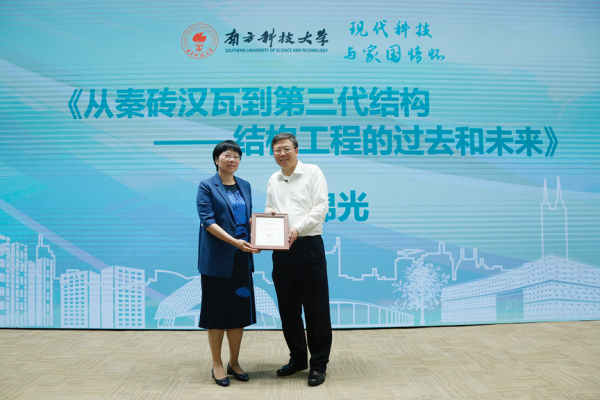Last week, Southern University of Science and Technology (SUSTech) Vice President Teng Jinguang gave the 13th lecture in the Modern Science, Technology and Your Love of Country lecture series. As an Academician of the Chinese Academy of Sciences and the Dean of the SUSTech Graduate School, Vice President Teng Jinguang spoke on the topic of “The Past and Future of Structural Engineering.” SUSTech University Council Chairperson Guo Yurong presided over the lecture.

Vice President Teng Jinguang spoke about his academic and professional experience, working hard from a young age. He was admitted to the Department of Civil Engineering at Zhejiang University, where he earned excellent results and was allowed to study abroad. During his Ph.D., he studied at universities in Australia, Canada and the United Kingdom. After receiving his doctorate, he decided to work “close to home,” by teaching at the Hong Kong Polytechnic University for more than 20 years, while researching composite materials that could potentially replace steel.
In his lecture, Vice President Teng Jinguang used the Sydney Opera House to explain the difference between architects and designers. He focused on structural materials and how they are a critical driver for the development of structural engineering. Vice President Teng Jinguang added that the progression from first generation natural materials to third generate synthetic materials over ten thousand years has promoted structural innovation in engineering for human architecture. He reflected on the variety of architectural forms, such as the Hong Kong-Zhuhai-Macao Bridge and the Bird’s Nest Stadium.
Vice President Teng Jinguang said that the second generation of industrialized artificial materials represented by reinforced concrete is common in infrastructure such as bridges, high-rise buildings and space structures. While these are versatile, they have a deadly “natural enemy” in rust. In order to solve this problem, researchers have researched and developed new composite materials and effectively realized the seismic strengthening of concrete structures. Vice President Teng Jinguang is a leader in designing and developing fiber-reinforced-polymer (FRP) steel-concrete double-skin tubular members. They have excellent ductility and seismic performance, giving them enormous commercial potential in marine and near-shore engineering.
Vice President Teng Jinguang concluded that structural engineering is the backbone of human settlements and critical to human civilization. Structural engineering supported by material renewal and computer data analysis will help China move steadily from a big civil engineering country to a strong civil engineering country.
Proofread ByXia Yingying
Photo ByWang Kaiqiang, Zhang Bowen